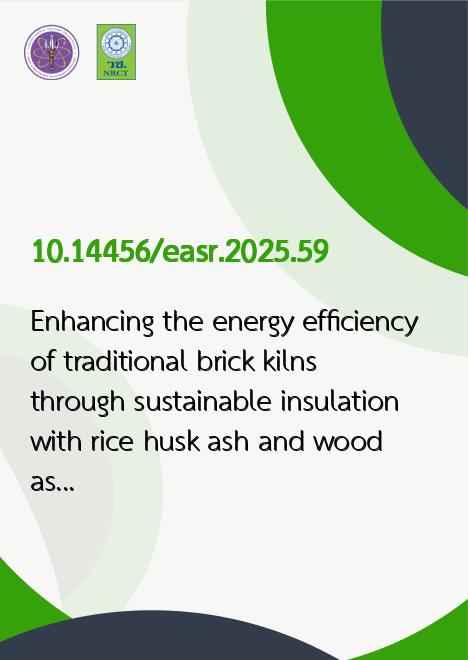
|
Enhancing the energy efficiency of traditional brick kilns through sustainable insulation with rice husk ash and wood ash |
|---|---|
| รหัสดีโอไอ | |
| Creator | Sopa Cansee |
| Title | Enhancing the energy efficiency of traditional brick kilns through sustainable insulation with rice husk ash and wood ash |
| Contributor | Nuntawat Butwong, Sarawut Saenkham, Teerasad Kanasri, Shenghua Hu, Worawut Promtown |
| Publisher | Faculty of Engineering, Khon Kaen University |
| Publication Year | 2568 |
| Journal Title | Engineering and Applied Science Research |
| Journal Vol. | 52 |
| Journal No. | 6 |
| Page no. | 648-658 |
| Keyword | Rice husk ash, Wood ash, Brick kiln, Thermal efficiency, Sustainable insulation |
| URL Website | https://ph01.tci-thaijo.org/index.php/easr/index |
| Website title | Engineering and Applied Science Research |
| ISSN | 2539-6161 |
| Abstract | This study investigates the use of rice husk ash (RHA) and wood ash (WA) as sustainable thermal insulators to enhance the energy efficiency of traditional brick kilns. As readily available byproducts of agricultural and biomass combustion processes, RHA and WA are low-cost materials that support circular economy practices. Their favorable physical properties, including low thermal conductivity, high porosity, and reactive silica content, make them suitable for use as insulation for kiln walls. Experiments were carried out using a scaled-down downdraft open-top kiln to evaluate the thermal performance across various wall thicknesses and compaction levels. The results indicated that WA, particularly in a 15 cm loose-fill configuration, achieved the lowest heat loss (23.24 MJ) and the highest thermal efficiency (54.42%), representing a 15.09% improvement compared to the control. This approach to insulation also reduced the unit energy cost per brick from 0.00487 to 0.00414 USD, yielding an estimated annual fuel saving of 588 USD and a payback period of 1.47 years (~20 batches). In addition to energy savings, the reuse of RHA and WA reduces landfill waste, mitigates reliance on virgin insulation materials, and contributes to emission reductions, potentially lowering the CO₂ output by up to 750 kg per year for small-scale kilns. These findings confirm that incorporating RHA and WA into kiln construction is a viable, cost-effective strategy for improving sustainability in artisanal and semi-industrial brick production. The results are scalable and adaptable to various geographical and climatic contexts, thereby supporting broader adoption in developing regions. |